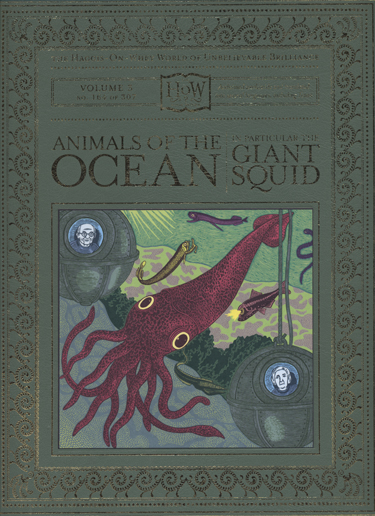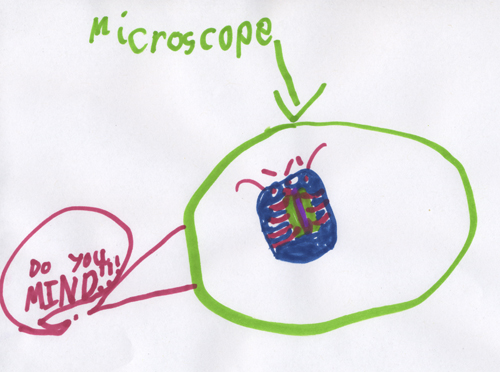 It will be no surprise to regular readers on this blog that the Free-Ride offspring like books. At this point, it is even possible that their books outnumber their parents’ books, which is almost alarming. (Please send compact shelving and a librarian who can break out some Dewey Decimal on our profusion!)
It will be no surprise to regular readers on this blog that the Free-Ride offspring like books. At this point, it is even possible that their books outnumber their parents’ books, which is almost alarming. (Please send compact shelving and a librarian who can break out some Dewey Decimal on our profusion!)
Naturally, this means the sprogs must grapple with the issue of which books are reliable sources of information and with the related issue of which books are appropriate for children. We consider as a test case Animals of the Ocean: In Particular the Giant Squid.
The book is hardbound and beautifully illustrated. It includes charts and labeled diagrams and boxes that highlight interesting details.
Is it a good book?
The elder Free-Ride offspring responds, “It’s a funny book.” Is it a source of reliable information about giant squids or other ocean creatures? “Probably not.”
The younger Free-Ride offspring notes, “Maybe some of it is true. But I don’t believe that curtains are why the dark part of the ocean is so dark.”
The elder offspring offers, “This book isn’t fact and it isn’t opinion. They’re just making it as silly as they can.”
So, how can we tell when a book is offering reliable information about a subject like the giant squid? “Maybe if there were photographs instead of just drawings?” muses the elder offspring. This book, however, includes some photographs, “and they could make up silly stuff even with photographs,” points out the younger offspring.
“Of course, we could look in the library in non-fiction,” says the elder offspring. “That’s where you can find books that are supposed to give facts.”
And here, the Free-Ride offspring wish respectfully to disagree with the assessment of this book offered by Katherine Sharpe:
This book is not for kids, because nothing in it is true. It’s wall-to-wall parody of genres and conventions that kids won’t know about. And it’s full of lies. Hilarious to you, perhaps, but guaranteed to be confusing to the young’uns.
Our observations with children (n=2) lead us to conclude that the book is also hilarious to children, notwithstanding their relative innocence of the genres and conventions parodied. Indeed, recall that Sesame Street plays with genres and conventions of which little kids are ignorant. Yes, it’s a naked attempt to draw in the parents and get them watching along with their kids, but that doesn’t mean that the kids don’t dig it, too.
The “full of lies” part is a point of difference between Animals of the Ocean: In Particular the Giant Squid and Sesame Street. However, kids of a certain age (in our sample, greater than or equal to 5 years 6 months) are starting to figure out how to distinguish plausible information from lies. They are becoming critical consumers of information. While this may be a good go-to book if your aim is to laugh your head off, they recognize that other books provide more authoritative sources of information about sea creatures. That they can make this judgment about a book that has the surface appearance of being a reliable source is, in my view, a good thing.
Besides, there are some bits of the book that might, accidentally, have some truth in them:
- Parts of the ocean are very dark (p. 12), although no trip to Pottery Barn was required to achieve this effect.
- There is a much higher pressure at the bottom of the ocean (p. 28), although why that should be and how a diver might properly deal with the high pressure at great depths is not really addressed here.
- Insufficiently prepared divers might well become very cold as a result of their insufficient preparation (p. 24).
- There is feces in the ocean, owing to sea creatures defecating there (pp. 26-27).
- Squids do have numerous appendages, even if none of them are used for “[s]imultaneous ‘up high,’ ‘down low,’ and ‘too slow'” (p. 9).
- The squid beak can be used to eviscerate other animals (a recurring motif throughout the book).
In other words, the various absurdities in this book can, after the giggling fits have subsided, provide the entry point for a discussion of what’s really going on with the sea.
We like this book. It’s the kind of book we might donate to an elementary school library they day before we moved out of town, just so we could giggle over how the librarian might react to the contents and how, ultimately, it would be catalogued.
* * * * * *
For your enjoyment, the sprogs offer some illustrations of their own:

I am uncertain whether the younger offspring intended the squids in this drawing to be giving each other five “up high”.

The elder offspring informs me that the plankton in this picture, upon whose privacy the microscopist rudely intrudes, is reading a very small edition of the giant squid book.

If they liked this, they will also like “Giraffes? Giraffes!” from the same series. It’s one of my favourite books.
I wonder if PZ has a copy on his reference shelf…..
Oh, the dangers inherent in raising overly analytical offspring…
How do you explain the bovines in space?
Dr Xargles book of Earthlets left my very literal 8yo (i.e. he stood up in the middle of Happy Feet and loudly denounced “This is biological fiction.”) crying he was laughing so hard when he rediscovered the book a year or two ago.
If you’re worried that your child might not understand parody you can always check in with them to see whether they understand the joke.
What my kids find much more annoying is sincere books that get the facts wrong, i.e. farm books where goats are eating tin cans (goats are quite fussy eaters) or what’s supposed to be a “straw” plant looks like a corn plant.
I agree with Brook, my kids really find books where the facts are incorrect to be the most frustrating. Books that claim to be “all about ….” with incorrect “facts” are really irritating to them and I often have to point out that these books may be 15 years out of date, the people who wrote them maybe didn’t do their homework to check their information, etc.
They also point out inconsistencies in movies and cartoons – where male bovines have udders, Spongebob and Patrick have a campfire underwater, and Jimmy Neutron flies his open-air rocket into outer space. [Of course, the parental units do a lot of this, so I think it is inherited behavior.]
Guess I’m raising some science/reality nerds, but I’m SOOO happy to be doing that, so I won’t complain about it.
I have been zinged! No, I mean not zinged, but given a new perspective. Perhaps I underestimated kids’ ability to identify and enjoy truth-bending. (Maybe it’s like the Amelia Bedelia books. Does anybody still read those?)
Also, great drawings.
Next birthday season they’re getting In Me Own Words: the Autobiography of Bigfoot and Me Write Book: It Bigfoot Memoir.
I guess you’d shelve last year’s presents, That’s Disgusting and That’s Dangerous, under Children’s Literature–Self-Help?
This thread just brought back to mind, again, a life event from +-15 years ago. The four of us (wife, husband, and two kids, then about 7 and 3) listened to books on tape during frequent long road-trips. On one particular trip, we ended up with a tape of E.B. White, himself, reading Charlotte’s Web. None of us have ever forgotten that tape, though the trip and destination have long since left our memories. And, phrases like, “What a gorge,” “That’s one of my idio-idio-idiosyncrasies,” and “That’s some pig!” still pop up in our conversations.